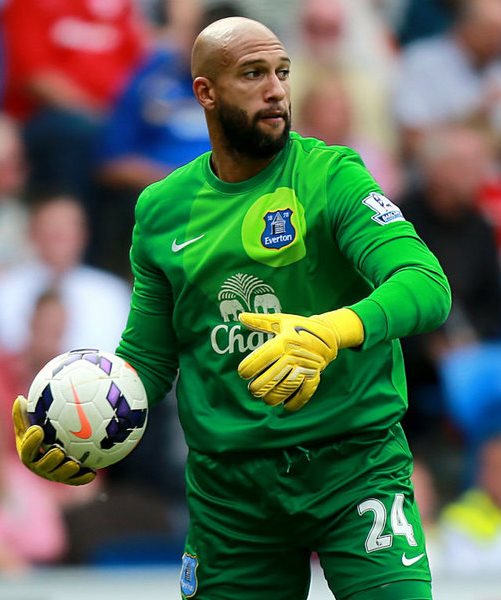|
I always accepted William Blake’s observation, “The tigers of wrath are wiser than the horses of instruction” – until I listened to Michael Jordan one night.
Jordan had just made some amazing aerial maneuver for a dunk in heavy traffic. I cannot remember if it was in the Garden or Chicago, but I was there. Afterward, a reporter asked Jordan how he had invented the move while in mid-air. Jordan normally sneered at “you guys” but this time he doubled up on his derision. “I’ve made that move a thousand times in the gym,” he said, patronizingly. Ever since then – 15 or 20 years – I have been vastly more respectful of repetition, performed by tigers of wrath, working on their moves 100 or 200 times per day in the gym or rehearsal room before they perform in the arena. The value of reps was brought home recently while I was simultaneously reading two books that turned out to have the same message. Practice makes. By sheer accident, I was reading Tim Howard’s “The Keeper,” skillfully co-written by Ali Benjamin, and Daniel Coyle’s “The Talent Code,” which I missed in 2009. As it happens, I know both people – Howard as one of the nicest athletes, Coyle as a colleague at the Tour de France who has done epic work exposing cheating in cycling. Howard recalls how he was taken in – for free – by Tim Mulqueen, Coach Mulch, a goalkeeper mentor in New Jersey: “He hammered ten in a row, so fast it was hard to get back on my feet between them. The moment I saved one, another was already whizzing past me. “'Recover faster,’ he barked. ‘You can do better than that.’” Coach Mulch also trained Howard to throw the ball rather than punt it, even in the closing desperate minutes. That way you have control. Fast forward to the 91st minute against Algeria in South Africa in 2010, when Howard started a full-field attack that kept the USA in the World Cup. The pass dated to New Jersey, two decades earlier. Howard could have sulked when Manchester United brought in Edwin van de Sar. Instead, Howard studied how van de Sar threw his long body to the ground, cradling the ball. Tim Howard imitated the man who had taken his job. The Howard book arrived over the transom from HarperCollins and the Coyle book was recommended by two disparate friends, a classical musician and a second-career keeper coach, who live 9,000 miles apart. Neither knew that Daniel Coyle is a friend of mine. The cellist and coach were both impressed by Coyle’s scientific description of how the human system learns the lessons of repetition, through a material called myelin. “(1) Every human movement, thought, or feeling is a precisely timed electric signal traveling through a chain of neurons – a circuit of nerve fibers. (2) Myelin is the insulation that wraps these nerve fibers and increases signal strength, speed, and accuracy. (3) The more we fire a particular circuit, the more myelin optimizes that circuit, and the stronger, faster, and more fluent our movements and thoughts become.” All the rest is practice. Gym rats. Musicians improvising with purpose. Teachers imposing order. Coyle has a great segment on a charter school (KIPP) in Houston. Students doing their reps, like Tim Howard diving for a save, over and over again, building up his myelin.
Andy Tansey
1/15/2015 01:55:16 pm
Listening to the Grateful Dead as I read and write. The revelation here to me is that improvisation is probably rarely the first time a feat is performed, but rather the first time it is performed under such circumstances. I have only been listening for about 45 minutes, and Garcia has blown me away a few times with improv.
George Vecsey
1/16/2015 01:12:22 am
Andy, good to hear from you. The Dead continue to delight, nearly 20 years after Jerry. I was on the treadmill the other night with The Dead Do Dylan -- Weir on the early vocals, Jerry on some later ones, and I could hear familiar drum riffs (like on the classic Peggy-O) and guitar riffs (like on Visions of Joanna, not on this album) which would be their signature sounds, and they know when to throw them in -- whether that is improvising or some deep feel for their own music, I don't know. As much of a mess as Jerry was, he had some inner feel for his talent that comes through, delight in disorder (as Herrick wrote). In the end, the Dead were a great team, like Maldini and Baresi covering each other. Best, GV 1/15/2015 03:25:10 pm
George
George Vecsey
1/16/2015 01:16:57 am
Alan, credit where credit is due, you touted me on the Coyle book. I loved the subjects listed for the Phila seminar. I learned a lot from DiCicco when he coached the women's team. He and his staff and Colleen Hacker understood what was in that locker room -- and they gave it plenty of room, never over-coached. Best, GV
Andy Tansey
1/17/2015 10:44:43 pm
Thank you, George and Alan, for the opportunity to share views.
George Vecsey
1/18/2015 01:46:22 am
Andy, wish I had any teaching back in the day, and I never coached soccer. (Did coach baseball....reps!...play pepper) 1/18/2015 09:58:12 am
Andy,
Gene Palumbo
1/20/2015 05:50:48 pm
George, Comments are closed.
|
Categories
All
|












